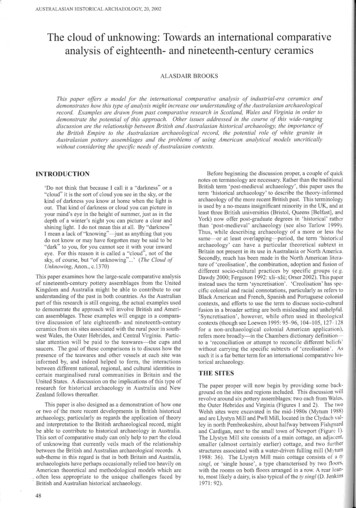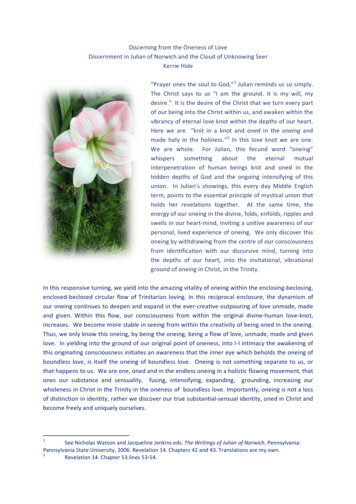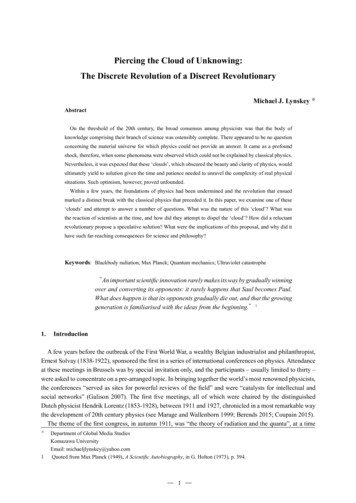
Transcription
AUSTRALASIAN I-IISTORICAL ARCHAEOLOGY, 20,2002The cloud of unknowing: Towards an international comparativeanalysis of eighteenth- and nineteenth-century ceramicsALASDAIR BROOICSThis paper offers a model for the international comparative analysis of indzistrial-era ceramics anddemonstrates how this type of analysis might increase our understanding ofthe Australasian archaeologicalrecord. Examples are drawn from past comparative research in Scotland, Wales and Krginia in order todenzonstrate the potential of this approach. Other issues addressed in the course of this wide-rangingdiscussion are the relationship between British and Australasian historical archaeology, the importance ofthe British Enzpire to the Austr-alasian archaeological record, the potential role of white granite inAustralasian pottery assemblages and the problems of using American analytical models uncriticallywithout considering the specij?c needs of Australasian contexts.INTRODUCTION'Do not think that because I call it a "darkness" or a"cloud" it is the sort o f cloud you see in the sky, or thekind o f darliiiess you know at home when the light isout. That kind o f darkness or cloud you can picture inyour mind's eye in the height o f summer, just as in thedepth o f a winter's night you can picture a clear andshining light. I do not mean this at all. By "darkness"I mean a lack o f "knowing"-just as anything that youdo not l a o w or may have forgotten may be said to be"dark" to you, for you cannot see it with your inwardeye. For this reason it is called a "cloud", not o f thesky, o f course, but " o f unknowing" .' (The Cloud ofUnknowing, Anon., c. 1370)This paper examines how the large-scale comparative analysiso f nineteenth-century pottery assemblages from the UnitedKingdoin and Australia inight be able to contribute to ourunderstanding o f the past in both countries. As the Australianpart o f this research is still ongoing, the actual examples usedto demonstrate the approach will involve British and American assemblages. These examples will engage in a comparative discussion o f late eighteenth- and nineteenth-centuryceramics from six sites associated with the rural poor in southwest Wales, the Outer Hebrides, and Central Virginia. Particular attention will be paid to the teawares-the cups andsaucers. The goal o f these comparisons is to discuss how thepresence o f the teawares and other vessels at each site wasinformed by, and indeed helped to form, the interactionsbetween different national, regional, and cultural identities incertain marginalised rural coinmunities in Britain and theUnited States. A discussion on the implications o f this type o fresearch for historical archaeology in Australia and NewZealand follows thereafter.This paper is also designed as a demonstration o f how oneor two o f the more recent developments in British historicalarchaeology, particularly as regards the application o f theoryand interpretation to the British archaeological record, inightbe able to contribute to historical archaeology in Australia.This sort o f comparative study can only help to part the cloudo f unknowing that currently veils much o f the relationshipbetween the British and Australian archaeological records. Asub-theme in this regard is that in both Britain and Australia,archaeologists have perhaps occasionally relied too heavily onAmerican theoretical and methodological models which areoften less appropriate to the unique challenges faced b yBritish and Australian historical archaeology.Before beginning the discussion proper, a couple o f quicknotes on terminology are necessary. Rather than the traditionalBritish term 'post-medieval archaeology', this paper uses theterm 'historical archaeology' to describe the theory-informedarchaeology o f the more recent British past. This tenninologyis used by a no-means insignificant minority in the U K , and atleast three British universities (Bristol, Queens [Belfast],andYork) now offer post-graduate degrees in 'historical' rathcrthan 'post-medieval' archaeology (see also Tarlow 1999).Thus, while describing archaeology o f a more or less thesame-or at least overlapping-period, the term 'historicalarchaeology' can have a particular theoretical subtext inBritain not present in its use in Australasia or North America.Secondly, much has been made in the North American literature o f 'creolisation', the combination, adoption and fusion o fdifferent socio-cultural practices by specific groups (e.g.Dawdy 2000; Ferguson 1992: xli-xlii; Orser 2002). This paperinstead uses the term 'syncretisation'. 'Creolisation' has spccific colonial and racial connotations, particularly as refers toBlack American and French, Spanish and Portuguese colonialcontexts, and efforts to use the term to discuss socio-culturalfusion in a broader setting are both inisleading and unhelpful.'Syncretisation', however, while often used in theologicalcontexts (though see Loewen 1995: 95-96,104-105, 127 128for a non-archaeological colonial American application),refers more broadly-in the Chambers dictionary definitionto a 'reconciliation or attempt to reconcile different bclicfs'without carrying the specific subtexts o f 'creolisation'. Assuch it is a far better term for an international com arativt:liistorical archaeology.THE SITESThe paper proper will now begin by providing some background on the sites and regions included. This discussion willrevolve around six pottery assemblages: two each from Walethe Outer Hebrides and Virginia (Figures 1 and 2). The twWelsh sites were excavated in the mid-1980s (Mytum 19and are Llystyn Mill and Pwll Mill, located in the Clydachley in north Pembrokeshire, about halfway between Fisl gnaand Cardigan, next to the small town o f Newport (FigurcThe Llystyn Mill site consists o f a main cottage, an adjacesmaller (almost certainly earlier) cottage, and two f r t hstructures associated with a water-driven fulling mill (Mqtu1988: 36). The Llystyn Mill main cottage consists o f asingl, or 'single house', a type characterised by two floorwith the rooins on both floors arranged in a row. A rear leato, most likely a dairy, is also typical o f the ty sirzgl ( D . Jenliil
United?astern USA showing .rite locations.
The majority of the 118 Llystyn Mill vessels date from themiddle and second half of the nineteenth century, with a peakof occupation from c. 1850 to 1870. There are earlier materials, and these appear to be the result of previous intermittentoccupation of the site, starting no earlier than 1800. Theabsence of certain pottery types indicates that the site wasabandoned near the end of the nineteenth century. The PwllMill cottage was much smaller than Llystyn Mill, and consisted of two sections: a main rooin featuring a fireplace at thefar end, and a later addition containing the bedroom, anarrangement known as ty dau ben or a 'two-ended house'(J. G. Jenltins 1976: 123). No traces of any partition survivedby the time the site was excavated, but the main room wasalmost certainly subdivided into a kitchen and living roomsection and a parlour section. Of the 90 vessels of the PwllMill assemblage, about 40% pre-date 1820, and 28% post-date1820, with the remaining third potelltially belonging to eitherperiod. The totality of the evidence suggests intermittentoccupation of the site dating from c.1790 to c.1850. A inorein-depth analysis of four Welsh assemblages, including thetwo in this paper, is forthcoming (Brooks in press).It is important to stress that we are not loolting at singlehouseholds over time with the Welsh assemblages, but ratherseveral intermittent households from a single socio-culturalgroup-the itinerant rural poor cottagers of Wales. Briefly,the late eighteenth and nineteenth centuries were a period oftremendous demographic and social change in rural Walesas they indeed were for Great Britain as a whole. For example, following a rapid rise in rural population through to the1820s and 1830s, a series of socioecono nicfactors includingcollapses in agricultural market prices, disastrous harvests, theclosing of every banlt in Peinbrokeshire and the lure of theexpanding South Wales coalfields led to a rapid decrease inthat population (Davies 1993: 35 1, 355; Howell 1993: 83-4). ndeed,the populatioil in some of the parishes in the Clydachvalley area more thail halved between 1831 and 185 1 (Lewis1972: 301), and David Williams (1955: 188-9) has describedthe people of southwest Wales as living in 'a state of semistarvation and spiritual malaise' during this period.Wales was hardly unique within Great Britain in facingupheaval during this period. What really marks out Walesfrom the rest of Britain and the United Kingdoin is that migration from rural Wales was largely internal to the Welsh industrial coalfields rather than the external overseas migration thatmarks out Ireland, Scotland, and even England. Emigrationdid take place, but at its peak, only 3 Welsh per 10 000 left forNorth America annually. This compares to 12 English, 20Scots, and 77 Irish per 10 000. Indeed, by the 1890s, thehunger for labour in the coalfields led to Wales becoming acountry of net immigration (G. Williams 1991: 178-1 80).Moving on to Scotland. the Hebridean sites from theislands of South Uist and Barra (Figure I) are both fairly typical Hebridean blacl houses. viththe exception that while thetraditional blackhouse comhines living space and a livestockbyre in a single building (Wallter & McGregor 1996: 3), theBarra byre is adjacent to the house (Brannigan & Foster 1995:93). The South Uist site is located in the Milton township, avillage of dispersed blachhot sesabout halfway along the eastem coast of the island. and perh; l?smore famous as the birthplace of Flora MacDonald. rornantic heroine of the 1745Jacobite rebellion (Anon. 1997: Syiuonds 1999). Virtually allof the 156 vessels in the Milton asseinblage indicate a peakoccupation dating from c. 1780 to c.1830 at the very latestthe terminal date fitting in very neatly with the clearances ofSouth Uist in the 1830s and 1840s. Thirteen modern vesselsdating no earlier than 1890 were also recovered from the site,but as these are unrelated to the main site occupation, theywere excluded from further comparative analysis. The secondHebrideail assemblage comes from a more isolated farm onthe southem coast of the island of Barra (Brannigan & Easter1995). This assemblage is soinething of an exception ill thisdiscussion as it consists of 0111 33 vessels. The sociocconomic factors relating to the small size of this a s e n i b l a g have been discussed elsewhere (Broolts 2000: 115-126). TheBarra vessels date entirely between 1780 to 1830, with a dep.osition peak between c. 1800 and c. 1820.The Hebridean households were far less transient thantheir Welsh counterparts. Indeed, the Barra household is theonly one of the four British sites to which a name, that ofJames Campbell and his family, can be attached (Brannipan &Foster 1995: 69). Despite this inore permanent occupatioil,the Hebridean sites were subject to a far more intense socialand geographic transformation than their Welsh counterparts.This is hardly the place to offer an in-depth deconstruction ofthe transformation of Hebridean society, but a brief survey follows. Towards the end of the eighteenth century, Island lifewas transformed by the old traditional landlords who \Yereincreasingly drawn into the emerging capitalist culture oilnetropolitan Britain, and who rationalised their holdings in anattempt to inaxiinise their profits from traditional Island products, particularly ltelp, an alkaline byproduct of seawecd usedin the production of glass and soap (Devine 1994: 32-5,37-8;Ennew 1980: 22; Hunter 1976: 11, 16; MacInnes 1988: 72;Symonds 1999: 111). So profitable was the kelp crop in theearly-nineteenth century that emigration was virtually bannedin a successful attempt to supply additional labour-SouthUist's population increased by 21 1% between 1755 and 1831,an increase itself only made possible by the expansion of thepotato crop (Hunter 1976: 25, 31).But the profits were only temporary. The end of theNapoleonic wars meant the re-introduction of foreign alkalisources to Britain, and the price of ltelp collapsed (Dcvine1994: 51-2; Hunter 1976: 35). But ltelping was now so centralto the island communities that it could not be abandoncd without causiilg the entire economic structure of the islands to follow the kelp price into oblivion. Except for sheep and wool,other Hebridean products such as cattle and fish had alsobecome economically unviable (Devine 1994: 51-2: Smout1969: 327). The landlords, the McNeills of Barra and Clanranald of South Uist, did their best to cope with an impossiblesituation, but in the 1830s, wholesale evacuations of the islandpopulations began (Hunter 1976: 39-40). By the end of thedecade, both families-now ba llluupt-had sold their ancestralland, and most of the remaining now-destitute population wascleared in the 1840s (Devine 1994: 67; McNeil 1995: 1 87).This leaves only the sites in the United States, both of'bvhichare located in central Virginia (Figure 2), and both of which arein some way associated with Thoinas Jefferson, third Prciidentof the United States. The first of these is the poor whitesans' house known as the StewartiWatkins site, localThomas Jefferson's Monticello plantation, just outside C'hlottesville. The site consists of a central structure with stonfoundations and a later addition (Heath 1991). This site xvaoriginally dated through documentary sources rather ththrough the pottery, something aided by Jefferson's hab'making voluminous notes on just about everything (e.g. Jeson 1987). The house was built in 1800, and occupicdc. 18 10. The Stewart family occupied the house until lateor 1809, and were followed by the Watkins family who ocpied the house for a year (Heath 1991). In keeping with tdates, the 126 vessels date from the end of eighteenth centuthe early nineteenth century. The Quarter Site is locatThomas Jefferson's less well-known Poplar Forest plantat1located just outside Lynchburg, Virginia. This site consist, 0slave quarter complex involving three small stiucturcs.which at least two were definitely dwellings (Heath 199Ploughing and erosion at the site have made it difficult to ass'specific vessels to specific households, so the 131 vessels fr
ANALYSISthis type of work has been done in North America than in theUK and Australia; it is certainly not being argued that American work should be discarded. Finally, in the next section ofthis paper, this example will be returned to in order to demonstrate how large-scale international comparisons can oflenrecontextualise conclusions in surprising new ways.that slaves in Bedford County, Virginia-where.is located-were buying goods directly fromts. The account books of merchant John Hookes for the accounts of sixteen slaves from twelveations at his New London (Bedford County)1771 and 1776. Accounts for a ftniher 35 or 36for Hook's Franklin County shop for the periodIn any case, the example of the interaction of cultural identity and pottery form distributions that will be used to introduce these themes is the concept of the African culinarygrammar. More specifically, Fergnson; a m g s t others, hastheorised that the high percentage of bowls that feature ineighteenth- and early-nineteenth-century African-Americanpottery assemblages is caused by the prominence of stews inthe African diet, and that this preference for a more liquid,stew-based diet transposed itself to the New World (Ferguson1992: 106-7). In comparison, pottery assemblages from thesame period'generated by free white Americans typically feam e relatively larger proportions of plates and teawares overbowls.This dichotomy is indeed present between the form distrbutions at the Quarter site and the StewartiWatkins site.Chart 1 shows the plate, bowl and teaware distributions atPlates, bowls and t e a w a r e s a t t h e Quarter and StewartlWatkins sitesteawaresforms1 and tenware distributions at the Qmner and StewartIWatkins sites.
p"i.rather than straight percentages for comparative purposes. Atthe Quarter site, there are nearly two plates to every bowl,while at the StewarttWatkins site there are seven plates toevery howl. With a slightly different comparison, at the Quar-part of the StewarVWatkins assemblage.At the risk of greatly oversimplifymg the range of interpretive approaches in American archaeology for the sake ofbrevity, a hypothetical North American interpretation of thisdata might be along the following lines: the higher proportionof bowls at the Quarter site indicates the continued relevanceof the African culinary grammar in Piedmont Virginia at theturn of the eighteenth century, while the higher number ofteawares at the Stewart Watkinssite show that concepts ofrefinement and the order and ritual of the Georgian Worldviewspread even to the white rural poor of Virginia. Even if theconcept of the African culinaqgrammar were to be rejectedand this is by no means a universally held perspective in theUnited States--one might well still describe the differencesied by the culturally-loaded teawares.Having presented this data, it is now possible to explortermed the 'Celtic Fringe'. The status connotationsteawares have been the subject of study by archaeologistshistorians on both sides of the Atlantic. WeatherillRichards have both discussed bow, in the eighteenth centhe drinking of tea was seen as a highly sociable activity, assof the behaviow of people of middle rank' (Weatherill 1157-9; Richards 1999). Shackel (1993: 107-9, 112-4)provided an archaeological example demonstrating the sperspective in eighteenth-century North America. Hereteawares were originally synonymous with social elites,represented a 'conspicuous display' of leisure time. Shackresearch demonstrated that in colonial rural Maryland,South U151Sites2.2: % of plates that are porcslaln or transfer-prlntsdsitesCharr 2: Tr 1 fer-pprintedandporcelain plates, bowls and teawares at the six sites, including Bowls (Chart 2.1). Plates (Charl2.2) and T &w(Chart 2.3).52
individuals from all social strata while nonethelessing certain inherent high-status associations.ty asthe century wore on. Of particular,shift in trans-Atlantic pottery tastes (dis-Celtic Fringe, particularly Scotland also appear ontransferprints. These images symbolise the extent to which certainimages of Celtic Britain had been romanticised and renderedsafe through appropriation by the elit-somethingwhich isperhaps best symbolised by George IV's notorious visit toEdinburgh in 1822, or pictures of Queen Victoria's Germanhusband wearing a kilt. In essence, the combined symbologyof all of these vessels suggests that the United Kingdom is nolonger a land of four very different peoples, but rather a singleentity. Of course, the co-existence of patterns representingboth merged and separate identities demonstrates how the tensions between the two were never fully resolved-though herethere is a danger that modem British politics perhaps colousour view of an ideology that enjoyed considerable success inits day. Thus these transfer-printed pattems served as subconscious propaganda promulgating the ideology of the newBritish identity-a topic discussed in some details by Colley(1996Fboth at home and abroad.However, while in an ideal world it would be possible toexcavate a Scottish or Welsh site and find nothing but transferprints with Scottish and Welsh scenes, not all subconsciouspropaganda is so overt-the real world is rarely so tidy. Thisdiscussion of pattems has so far focused on production; whathappened away from the pottery factory in the everyday livesof the Welsh and Hebridean poor is another matter entirely. Inthe case of teawares, there is little doubt that these potteryforms had little relevance to the traditional stew-based diet ofthe Hebrides or rural Wales. This stew-based diet required theuse of bowls, something which is perhaps most dramaticallydemonstrated by the B m a assemblage; w h e bowls compriseover 50 percent of the total assemblage. As previously noted,tea-dnnking was originally an activity associated with metropolitan elites. Thus the presence of teawares in the OuterHebrides dramatically demonstrates how material cultureclosely associated with ideologies themselves associated withthose elites gradually filtered through to the geographical andeconomic margins of the British Isles.It must be stressed that it is not being argued that Britishmetropolitan identity and ideology somehow replaced traditional socio-culturalbehaviour in the margins of Britain. Noris it being argued that the teawares are adopted as part of ananachronistically conscious rejection of Welshness andGaelicness or a conscious adoption of Britishness. Instead,this paper is only noting that the teawares can be seen as partof the growing influence of metropolitan ideologies amongstthe rural poor of Britain, and as part of the ongoing development of a syncretic culture that came to combine elements ofboth traditional and metropolitan behaviour and ideology.Non:theleza.IIis iniportmt to asknu vlcdgethat the negn-ti\. unnot311utisoften dssirned to rrsditi, nalGaclic andWelsh culture and identity within Britain, might well haveassisted the acceptance of metropolitan British culture. Afterall, if it is argued that teawares were implicitly higb-statuswares, and are associated with metropolitan ideologies, thereis a strong implication that 'British' culture was high statuswhile Hebridean and Welsh culture was low status. To themodem observer, this distinction will probably appear to bedeeply prejudiced, but the division was very much alive evenin the modem period-including amongst archaeologists. Thetitle alone of Curwen's 1938 Antiquity paper, 'The Hebrides:A Cultural Backwater', is itself indicative of past attitudes.More recently, Webster eventually gave up her attempt toidentify a specifically Hebridean tradition in survivingdressers and pottery, noting that:Hebridean families have sought to put behind them a histow,of overtv.In so doing thev have resisted the role ofguardians of ;meless tradizou &at the outside world hasattempted to impose upon them. (Webster 1999: 71-2).c.,
cepts of British identity or ideology. Instead, theteaware distributions are informed by racially-basgies of status based on the perceived differences betwhites and enslaved African-Americans. Here disc1return briefly to the African culiniuy grammar, an'the American assemblages to their Welsh and Hebri terparts.Meanwhile, the infamous 1848 report on the state of educalion in Wales, known locally as 'the treachery of the bluebooks', made a direct connection between the Welsh lan-ones390-392;1992: 103-165; G. i l l i a m s1991: 208).When these negative attitudes are combined with the socialtransformation of the Welsh and Hebridean environment,whether through the demographic transformation of ruralWales in the wake of industrialisation, or the arrival of crofting and the collapse of the kelp industry in the Hebrides, itsurely comes as little surprise that the households involvedslowly, but remorselessly and perhaps inevitably, came toinclude elements of the British worldview that was transforming their world into their everyday lives.Earlier, it was mentioned how (at the risk of ovcation) an American archaeologist might describeences between the StewartiWatkins and Quassemblages in terms of the conscious or unconsction of the European worldview by the enslaved Gcommunity. This might well be demonstrated by thcwhich are the most common forms at StewaWWatkjfar less common at the Quarter Site. At this point, itant to consider the distributions of the most cormacross all six of the sites (Chart 3). Without resorfull statistical discussion used in the original prescthis data (Brooks 2000: 170-174), the four most siare the Quarter site, Llystyn Mill, Pwll Mill and Swhile the two dissimilar sites are StewartWatkiisIf the differences between the two American assemINTERNATIONAL CONTEXTSAt this point, the discussion will retum to the American sites.Naturally enough, a very different environment is to be foundin the newly-independent United States of theStewarUWatkins and Quarter sites. Differences in teawaredistributions between these two sites are not based on con- 3.1: Distributions of seven most common formsplatebowlsaucerCUPforms.teapotgbow. .Llyrfyn MillIFw 1I MilStew artiWatkinrOunrtsrSouth UirfBarrasitesI'"1Chart 3; Distributions of the seven most commonform at the sir sites (Chart 31j, and the seven most commonforms as a percentage*(Chon 3.2j.::.JdI)i'!54
determined largely by an adherence to African culit would be necessluy to believe that the Welsh andlages have a closer cultural affinity to thean Quarter site than to the poor Euro-Ameritkins site. This somehow appears unlikely. If,and, the African culinary grammar is set aside,rences between the American assemblages signaled as a rejection, whether conscious or unconbeen a British cilony in the not-too-histant k t ) ,distributions similar to the African-Americany dissimilar from the Euro-American site.le answer is that the rural poor, irrespective ofground, traditionally (though, it must be stressed,exclusively) rely on stew-based diets. Relevantthis discussion include the bwyd llwy (spoonCottagers (Owen 1991: 9-10), the boiled stewsWest Africa (Ferguson 1992: 94), the milkthe Hebridean diet (Wehster 1999: 69), and thes mixtures' of the slaves and overseers of thecan south (Otto 1980: 10). With this in mind, itthat there is a higher ratio of howls to plates atish sites than even at the Quarter site. Most ofare fairly close, but in the case of the Barra assemire four bowls to every plate.the StewartiWatkins site are particularlyiscussion. It is the only one of the fivewls are outnumbered by teawares. Indeed,many teawares at this site as bowlscombined. It therefore appears entirely possibledeterminant in the American form distribueptions of African ethnicity, but rather econhough the former should by no means bed. More specifically, it is not being arguedcan-Americans had abandoned socio-culorigin, or that these should not bechaeologically, but rather that overallican pottery form distributions, particularly asares and bowls, are not conditioned by Africanmore than Welsh or Hebridean form distribur people traditionally tend to eat stews. Stews. Eighteenth- and nineteenth-century sites,mralpoor will thus in most cases have relativelyion to this rural poor theory is thesite, and here the teawares are the kev. In thise contc.xl, 11 seems more likely tI1.u the JirkrcncesQuaner iitc and Stewtin \Vxkins osscrnh13gss arcbeir cultural roots or rejecting Euro-Americaner by the poor free whites differentiating themenslaved population by acquiring material culstatus connotations, in this case teawares,her consciously or unconsciously-rejecte and food with strongly negative connotas case bowls and stews. When the American'are examined in trans-Atlantic context, it seemsable that it is the poor whites who are differentie norm of the marginalised rural poor, not thearative research also suggests that someal Nortb American ceramics methodologyalnated. Some methods, such as the meansimply statistically unsound (Brooks 2000:,which, while interesting, is a point that liese of this paper. More interestingly for this dissuch as Miller's CC index (Miller 1980; 1991),are revealed as valuable research tools in the United States, butvirtnally worthless in the rest of the world. The CC index is anAmerican means of calculating the relative worth of certainpottery assemblage components based on decoration and form,and with app opriateadjustments across time. This is can be apowerful research tool in the United States, but the British andAmerican pottery markets olten differed significantly in thewake of American independence. While broader Miller-basedobservations on which types are more expensive than othersappear to remain valid, the specific CC index values almostcertainly do not when removed from an American context. Upuntil 1812, the United States was largely used as a dumpingground for cheap British materials, while from c.1845 thewhite granite ware type replaced transfer-prints as the mostfashionable common tableware in North Arnelica (Ewins 1997:18-37), but is hardly ever recovered from domestic sites in itscountry of production. Indeed, to the best of this author'sknowledge, only two white granite vessels have ever beenrecovered from nineteenth century British domestic sites, bothfrom a Welsh cottage not included in this paper's discussion(Brooks in press). Thus a quantitative tool designed to calculate relative values in the United States, and often invaluable inthat specific context, is considerably less helpful in other contexts due to international variations in taste and supply (Brooks2000: 18&188,192-194,210-211).If this type of comparative analysis bas had implicationsfor both British and American historical archaeology, then itequally has potential implications for historical archaeology inAustralia and indeed New Zealand-though the focus of thispaper is very much on the former. Research in this regaid isstill ongoing, but nonetheless there are a few issues that can beraised in this paper. During the nineteenth century, the mostimportant global social and economic entity was the BritishEmpire, of which both Australia and Great Britain were components; the archaeological implications of this point havepreviously been raised by Lawrence (in press). Theoryinformed comparisons between analogous assemblages fromBritain and Australia will be able to provide valuable information on many points. One example would be the study of thetension between the emergence of a distinctly Australian tastein ceramics and the Metropole's use of subsidiary markets as adumping ground for unfashionable materials-as indeed bappened in the USA until
This sort of comparative study can only help to part the cloud of unknowing that currently veils much of the relationship between the British and Australian archaeological records. A sub-theme in this regard is that in both Britain and Australia, archaeologists have perhaps occasionally relied too heavily on










